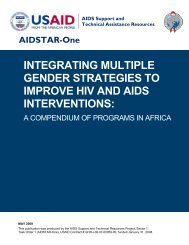Guide for Community Assessments on Women's Health Care - ICRW
Guide for Community Assessments on Women's Health Care - ICRW
Guide for Community Assessments on Women's Health Care - ICRW
You also want an ePaper? Increase the reach of your titles
YUMPU automatically turns print PDFs into web optimized ePapers that Google loves.
A5. Opportunistic Infecti<strong>on</strong>s (OIs)<br />
What are Opportunistic Infecti<strong>on</strong>s?<br />
Opportunistic infecti<strong>on</strong>s (OIs) are HIV- and AIDS-related illnesses caused by bacteria, fungi and<br />
viruses that take advantage of a weakened immune system. OIs would not normally cause illness in<br />
a healthy pers<strong>on</strong>, but can affect an HIV-infected pers<strong>on</strong> whose immune system has been weakened.<br />
Most OIs can be prevented or treated with medicati<strong>on</strong>, which can help improve the quality of life <str<strong>on</strong>g>for</str<strong>on</strong>g><br />
a pers<strong>on</strong> living with HIV and delay the <strong>on</strong>set of AIDS.<br />
There are more than 20 opportunistic diseases associated with AIDS, including tuberculosis (TB),<br />
diarrhea, pneum<strong>on</strong>ia, bowel infecti<strong>on</strong>, Kaposi’s Sarcoma, candidiasis, skin cancer and meningitis. An<br />
individual with an AIDS diagnosis may have two or more diseases at the same time.<br />
When AIDS first appeared in the mid-1980s, many people living with HIV rapidly died from<br />
opportunistic infecti<strong>on</strong>s because their doctors did not know how to treat and prevent these<br />
diseases in people with damaged immune systems. But as doctors learned how to prevent OIs with<br />
medicati<strong>on</strong>, and how to recognize and treat these infecti<strong>on</strong>s more effectively, people living with HIV<br />
began to live l<strong>on</strong>ger.<br />
Different Types of Opportunistic Infecti<strong>on</strong>s<br />
Tuberculosis (TB) is a lung disease that affects many people with HIV. It is preventable and curable.<br />
Candidiasis is a fungal infecti<strong>on</strong>, comm<strong>on</strong>ly known as “thrush” in infants. It appears as white patches<br />
<strong>on</strong> the t<strong>on</strong>gue and ulcers in the mouth. These patches are sometimes painful, making it difficult<br />
to swallow. This fungal infecti<strong>on</strong> can also affect the vagina, causing vaginal candidiasis. Symptoms<br />
include thick, curd-like vaginal discharge, painful intercourse and redness of the vaginal wall.<br />
Kaposi’s Sarcoma is a cancer comm<strong>on</strong>ly diagnosed in people living with HIV. Symptoms include<br />
dark skin lesi<strong>on</strong>s or nodules appearing <strong>on</strong> different parts of the body. It usually affects the skin, the<br />
lymph nodes and the mouth. Lesi<strong>on</strong>s also can be found in the stomach and the lungs, causing severe<br />
breathing problems.<br />
Pneumocystis Carinii Pneum<strong>on</strong>ia (PCP) is an infecti<strong>on</strong> of the lungs that can cause severe pneum<strong>on</strong>ia<br />
and results in difficulty breathing, fever and dry cough.<br />
How to Prevent or Treat Opportunistic Infecti<strong>on</strong>s<br />
●●<br />
●●<br />
●●<br />
●●<br />
●●<br />
Maintain regular medical check-ups. Seek medical care at the first sign of sickness.<br />
Get plenty of rest, good food and nutriti<strong>on</strong>, good hygiene, and avoid alcohol and smoking.<br />
Avoid infecti<strong>on</strong>: Many people fear getting infecti<strong>on</strong>s from people living with HIV, but in fact<br />
they have more to fear from getting infecti<strong>on</strong>s from “healthy” people.<br />
Access TB preventi<strong>on</strong> therapy.<br />
Use available medicines to cure most infecti<strong>on</strong>s or reduce the impact of the symptoms (e.g.,<br />
reduce itchiness of skin rashes).<br />
Annex A: Fact Sheets 85

















